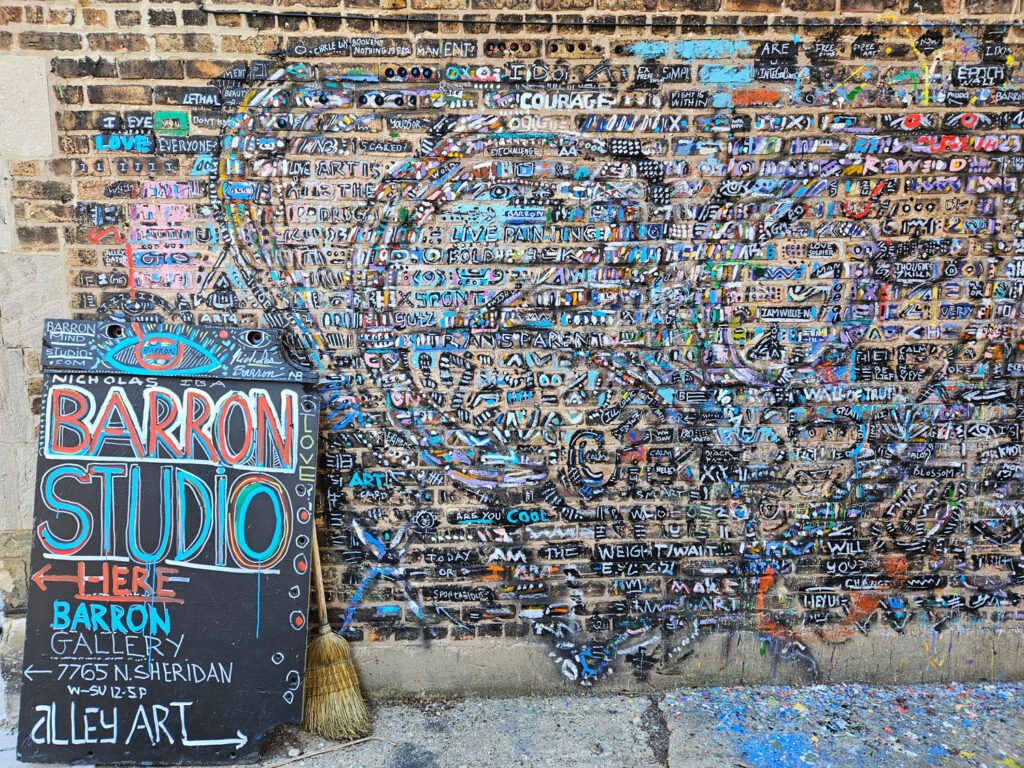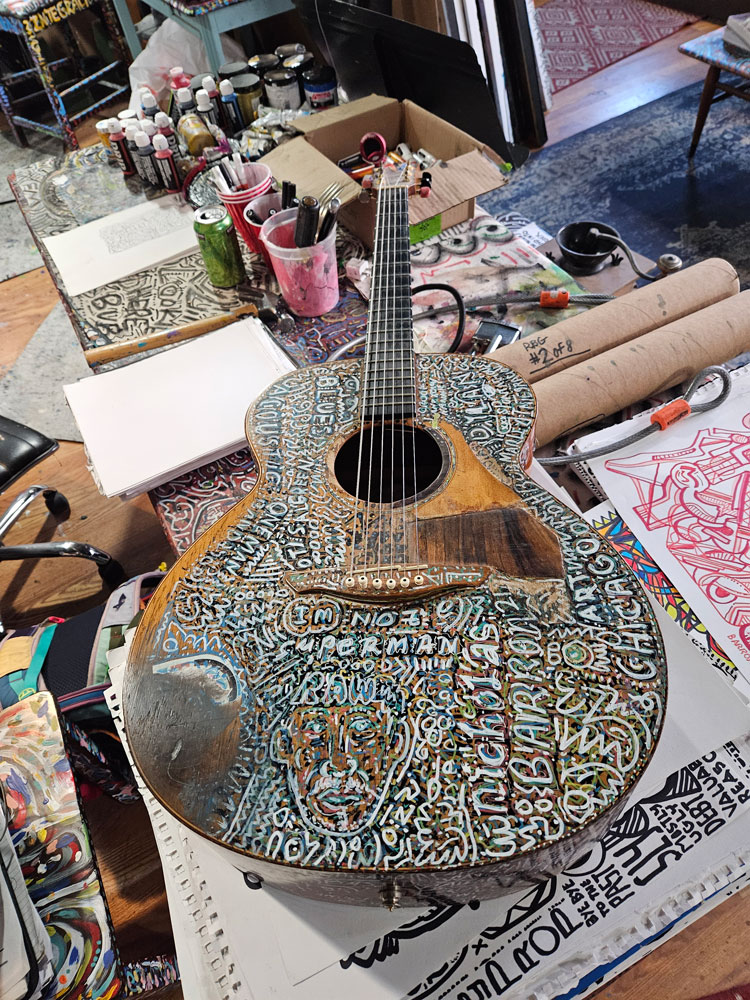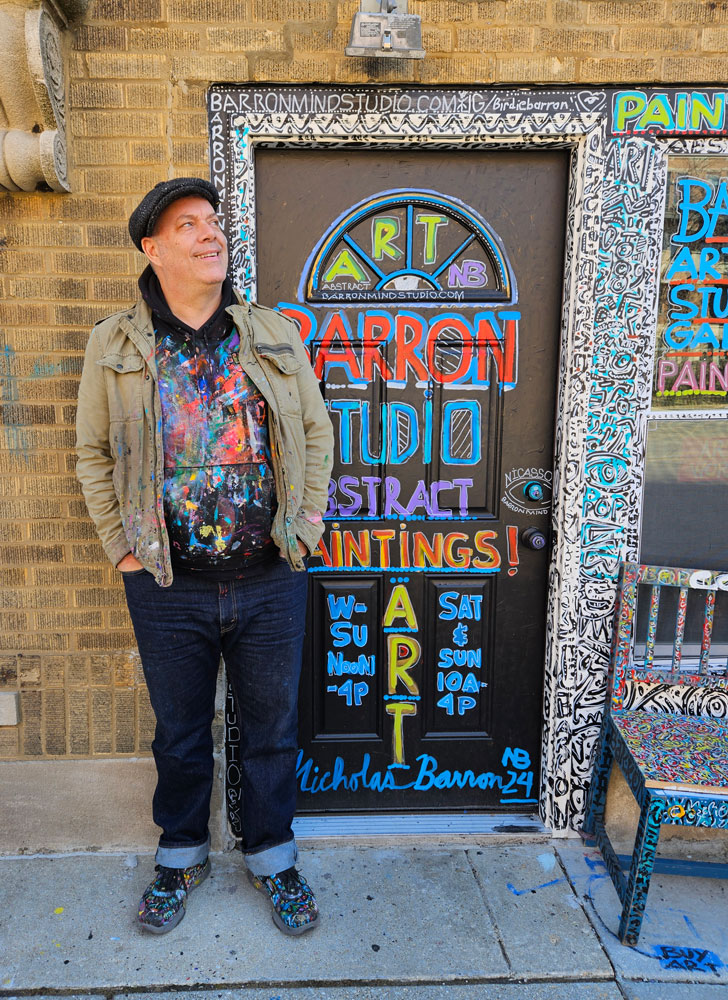What is perhaps the northernmost art gallery in Chicago is on the Sheridan Bend, the s-curve that swooshes toward the lake before crossing the Evanston city limits. It is run by, and devoted to the work of, one man: Nicholas Barron, a 58-year-old musician who discovered a vocation for painting in midlife. Not just canvases, but anything he can smear with a brush: brick walls, tables, chairs, guitars, windows, and the front door, which advertises BARRON STUDIO ABSTRACT PAINTINGS! The blue doorknob is the pupil of an eye labeled “Nicasso” and “Barronmind.” The frame is decorated with squiggly figures inspired by one of Barron’s New York ’80s idols, Keith Haring.
Barron paints and paints and paints. The walls of his studio are covered with big, bright, neo-expressionist paintings, which he sells for up to $4,000. But he also has milk crates filled with tiny paintings, for just $50. A painting for every pocketbook. Lift the lid of Barron’s toilet, and you’ll see a sketchy eye above the words ART? Barron. There are faces in his electric guitar. On the bricks in the alley are the words “courage,” “fight is within,” “love soldier.” His hoodie is stained with a Pollock-esque splatter that looks like a multicolored galactic explosion.
As a musician, his Nicholas Barron Band has opened for Al Green and B.B. King at House of Blues. He headlines smaller gigs at Riverwalk, Tiny Tap, and Simon’s. Barron didn’t take up art until he was in his 40s, after a divorce that separated him from his daughter.
“In 2008, my then-wife left with my daughter and went to Michigan, and I was depressed,” Barron recalls. “Singing and songwriting wasn’t enough, so I started painting. I knew that was what I was supposed to do as much as music.”
Gradually, painting began to replace music as Barron’s most essential form of expression. He could paint all day to fill the empty spaces in his life. He didn’t need an audience. The COVID-19 pandemic, which shut down all the bars, finally made Barron a full-time artist.

“I’m a singer, songwriter,” he says. “Now I make my living doing this. During the pandemic, I lost all my gigs, so it pays the rent here. I’m open Wednesday through Sunday and I generally paint every day. Even my days off I find myself going into painting because I’m kind of addicted to it.”
Barron’s father, Thomas, was a painter of traditional landscapes, but Barron is inspired by the New York Neo-Expressionists, specifically Haring and Jean-Michel Basquiat, who both died young, one of AIDS, the other of a heroin overdose.
“I’m just kind of spontaneous, creative, almost like an avant-garde jazz musician,” he says. “I think the music is in there, the rhythm and the flow, but I also think that I have my own voice with art because I’ve been doodling and drawing my whole life.”
Barron lives in an apartment upstairs from his studio, which was offered to him by the building’s manager, Joe Quinlan, who knew he was an artist, and wanted to provide him with a showcase for his work.
“The amount of people that pass every day is remarkable,” Barron says. “People stop their cars. I’ve got a painting in front and eventually, hopefully, people check it out and buy stuff. I just feel like it’s a huge gift to have this. It’s really visible.”

Barron’s studio is also across the alley from the final home of photographer Vivian Maier, who, in her dotage, rooted through the trash bins at Juneway Beach. (At the time, of course, no one knew about the thousands of negatives hidden in a storage bin.)
“I was kind of thinking there’s some kind of connection because she was next door and I feel like there’s this energy here,” Barron says. “What I’m doing is kind of a rare thing. I’m basically showing the world, just by showing up and being who I am, I’m an authentic person. I’m not worried about money. I’m not afraid of the things that we’re conditioned in our culture to be afraid of. It’s definitely about freedom and being who you are.”
Nicholas Barron thinks of himself as Rogers Park’s neighborhood artist. And freedom and being who you are is what Rogers Park is all about.



